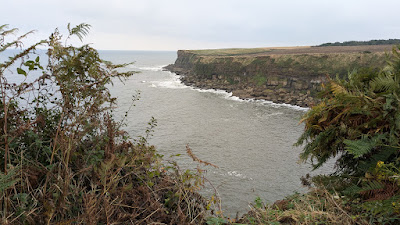Wednesday, 25 September 2024
Train trip: Filey to Scarborough
Tuesday, 24 September 2024
Train trip: Cloughton Wyke to Hayburn Wyke
The bay is stunning, with large blocks of Jurassic sandstone rock at the base of the cliffs, the clifftops clothed on bracken. A Fulmar circles over the cliff.
I have my pack lunch by the stream, looking at the bay. The stream is in spate, the waterfall magnificent, but this means the stream is hard to cross at the beach, so I can't access the Dark Bush-cricket spot. Not that it matters, it is a cloudy, cool day, so they are unlikely to be active.
Saturday, 14 September 2024
Train trip: Around Robin Hood's Bay
A long trip including a train ride to Scarborough and a bus drive to Brow Top to walk from there to Robin Hood's Bay. Brow top is in moorland, which appears to be managed for grouse as there are very obviously burnt patches. I fail to find Mossy Mere, a name that suggests a boggy area, but there are no paths and the heather is woody in many places. A Stonechat sits on a gorse bush and meadow pipit flocks fly off. I reach the trig point marking 220 m, and then it's mostly downhill, meandering alongside country lanes and minor roads. I have taken my Echo meter detector to check for bush crickets. The views are wonderful, the day mild, with no wind.


















































